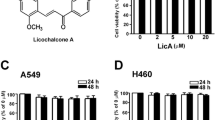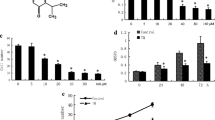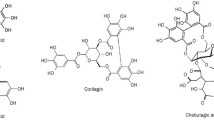Abstract
α-Tomatine, isolated from Lycopersicon esculentum Linn., is a naturally occurring steroidal glycoalkaloid in immature green tomatoes. Some reports demonstrated that α-tomatine had various anticarcinogenic properties. The purpose of this study is to investigate the anti-metastatic effect of α-tomatine in NCI-H460 human non-small cell lung cancer cells. First, the results showed that α-tomatine significantly suppressed the abilities of the adhesion, invasion, and migration of NCI-H460 cells under non-cytotoxic concentrations. Molecular data also showed α-tomatine could inhibit the activation of focal adhesion kinase (FAK) and phosphatidylinositol 3-kinase (PI3K)/Akt signal involve in the downregulation the enzyme activities, protein and messenger RNA levels of matrix metalloproteinase-7 (MMP-7). Next, α-tomatine also strongly inhibited the degradation of inhibitor of kappaBα (IκBα) and the nuclear levels of nuclear factor kappa B (NF-κB). Also, a dose-dependent inhibition on the binding ability of NF-κB by α-tomatine treatment was further observed. Furthermore, α-tomatine significantly decreased the levels of phospho-Akt and MMP-7 in Akt1-cDNA-transfected cells concomitantly with a marked reduction on cell invasion and migration. Presented results indicated α-tomatine might be further application for treating cancer metastasis.








Similar content being viewed by others
Abbreviations
- MMPs:
-
Matrix metalloproteinases
- ECM:
-
Extracellular matrix
- MAPK:
-
Mitogen-activated protein kinase
- ERK:
-
Extracellular signaling-regulating kinase
- JNK/SAPK:
-
c-Jun N-terminal kinase/stress-activated protein kinase
- PI3K:
-
Phosphoinositide 3-kinase
- NF-κb:
-
Nuclear factor kappa B
- AP-1:
-
Activator protein-1
- IκB:
-
Inhibitor of NF-κB
References
Greenlee, R. T., Hill-Harmon, M. B., Murraym, T., & Thunm, M. (2001). Cancer statistics, 2001. CA: A Cancer Journal for Clinicians, 51, 15–36.
Gupta, G. P., & Massague, J. (2006). Cancer metastasis: Building a framework. Cell, 127, 679–695.
Jemal, A., Murray, T., Ward, E., Samuels, A., Tiwari, R. C., Ghafoor, A., et al. (2005). Cancer statistics, 2005. CA: A Cancer Journal for Clinicians, 55, 10–30.
Mitra, S. K., & Schlaepfer, D. D. (2006). Integrin-regulated FAK-Src signaling in normal and cancer cells. Current Opinion in Cell Biology, 18, 516–523.
Stupack, D. (2007). The biology of integrins. Oncology, 21, 6–12.
van Nimwegen, M. J., & van dewater, B. (2007). Focal adhesion kinase: A potential target in cancer therapy. Biochemical Pharmacology, 73, 597–609.
Filder, I. J. (2005). The organ microenvironment and cancer metastasis. Differentiation, 70, 498–505.
Shih, Y. W., Chen, P. S., Wu, C. H., Jeng, Y. F., & Wang, C. J. (2007). α-Chaconine-reduced metastasis involves a PI3K/Akt signaling pathway with downregulation of NF-κB in human lung adenocarcinoma A549 cells. Journal of Agriculture and Food Chemistry, 55, 11035–11043.
Khwaja, A. (1999). Akt is more than just a Bad kinase. Nature, 401, 33–34.
Chan-Hui, P. Y., & Weaver, R. (1998). Human mitogen-activated protein kinase kinase kinase mediates the stress-induced activation of mitogen-activated protein kinase cascades. The Biochemical Journal, 336, 599–609.
Trusolino, L., & Comoglio, P. M. (2002). Scatter-factor and semaphoring receptors: Cell signalling for invasive growth. Nature Reviews Cancer, 2, 289–300.
Chen, P. N., Hsieh, Y. S., Chiou, H. L., & Chu, S. C. (2005). Silibinin inhibits cell invasion through inactivation of both PI3K-Akt and MAPK signaling pathways. Chemico-Biological Interactions, 156, 141–150.
Kwon, G. T., Cho, H. J., Chung, W. Y., Park, K. K., Moon, A., & Park, J. H. (2009). Isoliquiritigenin inhibits migration and invasion of prostate cancer cells: possible mediation by decreased JNK/AP-1 signaling. The Journal of Nutritional Biochemistry, 20, 663–676.
Lee, S. J., Park, S. S., Lee, U. S., Kim, W. J., & Moon, S. K. (2008). Signaling pathway for TNF-alpha-induced MMP-9 expression: Mediation through p38 MAP kinase, and inhibition by anti-cancer molecule magnolol in human urinary bladder cancer 5637 cells. International Immunopharmacology, 8, 1821–1826.
Nagase, H., & Woessner, J. F., Jr. (1999). Matrix metalloproteinases. The Journal of Biological Chemistry, 274, 21491–21494.
Westermarck, J., & Kahari, V. M. (1999). Regulation of matrix metalloproteinase expression in tumor invasion. The FASEB Journal, 13, 781–792.
Viatour, P., Merville, M. P., Bours, V., & Chariot, A. (2005). Phosphorylation of NF-kappaB and IkappaB proteins: Implications in cancer and inflammation. Trends in Biochemical Sciences, 30, 43–52.
Karin, M., & Ben-Neriah, Y. (2000). Phosphorylation meets ubiquitination: The control of NF-[kappa]B activity. Annual Review of Immunology, 18, 621–663.
Kunnumakkara, A. B., Anand, P., & Aggarwal, B. B. (2008). Curcumin inhibits proliferation, invasion, angiogenesis and metastasis of different cancers through interaction with multiple cell signaling proteins. Cancer Letters, 269, 199–225.
Lee, S. O., Jeong, Y. J., Im, H. G., Kim, C. H., Chang, Y. C., & Lee, I. S. (2007). Silibinin suppresses PMA-induced MMP-9 expression by blocking the AP-1 activation via MAPK signaling pathways in MCF-7 human breast carcinoma cells. Biochemical and Biophysical Research Communications, 354, 165–171.
Friedman, M., & Levin, C. E. (1995). α-Tomatine content in tomato and tomato products determined by HPLC with pulsed amperometric detection. Journal of Agriculture and Food Chemistry, 43, 1507–1511.
Lee, K. R., Kozukue, N., Han, J. S., Park, J. H., Chang, E. Y., Baek, E. J., et al. (2004). Glycoalkaloids and metabolites inhibit the growth of human colon (HT29) and liver (HepG2) cancer cells. Journal of Agriculture and Food Chemistry, 52, 2832–2839.
Morrow, W. J. W., Yang, Y. W., & Sheikh, N. A. (2004). Immunobiology of the tomatine adjuvant. Vaccine, 2004(22), 2380–2384.
Chiu, F. L., & Lin, J. K. (2008). Tomatidine inhibits iNOS and COX-2 through suppression of NF-κB and JNK pathways in LPS-stimulated mouse macrophages. FEBS Letters, 582, 2407–2412.
Mosmann, T. (1983). Rapid colorimetric assay for cellular growth and survival: Application to proliferation and cytotoxicity assays. Journal of Immunological Methods, 65, 55–63.
LeBel, C. P., Ischiopoulos, H., & Bondy, S. C. (1992). Evaluation of the probe 2,7-dichloro-fluorescin as indicator of reactive oxygen species formation and oxidative stress. Chemical Research in Toxicology, 5, 227–231.
Hisin, P. J., & Hilf, R. (1976). A fluorometric method for determination of oxidized and reduced glutathione in tissues. Analytical Biochemistry, 74, 214–226.
Ochi, Y., Atsumi, S., Aoyagi, T., & Umezawa, K. (1993). Inhibition of tumor cell invasion in the Boyden chamber assay by a mannosidase inhibitor, mannostatin A. Anticancer Research, 13, 1421–1424.
Chu, S. C., Chiou, H. L., Chen, P. N., Yang, S. F., & Hsieh, Y. S. (2004). Silibinin inhibits the invasion of human lung cancer cells via decreased productions of urokinase-plasminogen activator and matrix metalloproteinase-2. Molecular Carcinogenesis, 40, 143–149.
Ito, H., Duxbury, M., Benoit, E., Clancy, T. E., Zinner, M. J., Ashley, S. W., et al. (2004). Prostaglandin E2 enhances pancreatic cancer invasiveness through an Ets-1-dependent induction of matrix metalloproteinase-2. Cancer Research, 64, 7439–7446.
Ma, W., Lim, W., Gee, K., Aucoin, S., Nandan, D., Kozlowski, M., et al. (2001). The p38 mitogen-activated kinase pathway regulates the human interleukin-10 promoter via the activation of Sp1 transcription factor in lipopolysaccharide stimulated human macrophages. The Journal of biological chemistry, 276, 13664–13674.
Lin, H. H., Chen, J. H., Kuo, W. H., & Wang, C. J. (2007). Chemopreventive properties of Hibiscus sabdariffa L. on human gastric carcinoma cells through apoptosis induction and JNK/p38 MAPK signaling activation. Chemico-Biological Interactions, 165, 59–75.
Chandra, J., Samali, A., & Orrenius, S. (2000). Triggering and modulation of apoptosis by oxidative stress. Free Radical Biology and Medicine, 29, 323–333.
Chakraborti, S., Mandal, M., Das, S., Mandal, A., & Chakraborti, T. (2003). Regulation of matrix metalloproteinases: An overview. Molecular and Cellular Biochemistry, 253, 269–285.
Brockman, J. A., Scherer, D. C., McKinsey, T. A., Hall, S. M., Qi, X., Lee, W. Y., et al. (1995). Coupling of a signal response domain in IκBa to multiple pathways for NF-kB activation. Molecular and Cellular Biology, 15, 2809–2818.
Chataing, B., Concepcion, J. L., de Cristancho, N. B., & Usubillaga, A. (1997). Estudio clinico de la efectividad de extractos alcaloides obtenidos de los frutos del Solanum americanum Miller sobre el Herpes simplex, Herpes Zoster y Herpes genitalis. Revista de la Facultad de Farmacia, 32, 18–25.
McGehee, D. S., Krasowski, M. D., Fung, D. L., Wilson, B., Gronert, G. A., & Moss, J. (2000). Cholinesterase inhibition by potato glycoalkaloids slows mivacurium metabolism. Anesthesiology, 93, 510–519.
Rajananthanan, P., Attard, G. S., Sheikhh, N., & Morrow, W. J. (2000). Novel aggregate structure modulate lymphocyte proliferation and Th1 and Th2 cytokine profiles in ovalbumin immunized mice. Vaccine, 18, 140–152.
Parsons, J. T. (2003). Focal adhesion kinase: The first ten years. Journal of Cell Science, 116, 1409–1416.
Fujii, T., Koshikawa, K., Nomoto, S., Okochi, O., Kaneko, T., Inoue, S., et al. (2004). Focal adhesion kinase is overexpressed in hepatocellular carcinoma and can be served as an independent prognostic factor. Journal of Hepatology, 41, 104–111.
Mukhopadhyay, N. K., Gordon, G. J., Chen, C. J., Bueno, R., Sugarbaker, D. J., & Jaklitsch, M. T. (2005). Activation of focal adhesion kinase in human lung cancer cells involves multiple and potentially parallel signaling events. Journal of Cellular and Molecular Medicine, 9, 387–397.
Akasaka, T., van Leeuwen, R. L., Yoshinaga, I. G., Mihm, M. C., & Byers, H. H. (1995). Focal adhesion kinase (p125FAK) expression correlates with motility of human melanoma cell lines. The Journal of Investigative Dermatology, 105, 104–108.
Owens, L. V., Xu, L., Craven, R. G., Dent, G. A., Weiner, T. M., Kornberg, L., et al. (1995). Overexpression of the focal adhesion kinase (p125FAK) in invasive human tumors. Cancer Research, 55, 2752–2755.
Weiner, T. M., Liu, E. T., Craven, R. J., & Cance, W. G. (1993). Expression of focal adhesion kinase gene and invasive cancer. Lancet, 342, 1024–1025.
Sonoda, Y., Watanabe, S., Matsumoto, Y., Aizu-Yokota, E., & Kasahara, T. (1999). FAK is the upstream signal protein of the phosphatidylinositol 3-kinase-Akt survival pathway in hydrogen peroxide-induced apoptosis of a human glioblastoma cell line. The Journal of Biological Chemistry, 274, 10566–10570.
Huang, C., Jacobson, K., & Schaller, M. D. (2004). MAP kinases and cell migration. Journal of Cell Science, 117, 4619–4628.
Rudolph-Owen, L. A., Chan, R., Muller, W. J., & Matrisian, L. M. (1998). The matrix metalloproteinase matrilysin influences early stage mammary tumorigenesis. Cancer Research, 58, 5500–5506.
Sasaki, H., Yukiue, H., Moiriyama, S., Kobayashi, Y., Nakashima, Y., Kaji, M., et al. (2001). Clinical significance of matrix metalloproteinase-7 and Ets-1 gene expression in patients with lung cancer. Journal of Surgical Research, 101, 242–247.
Aguirre Ghiso, J. A., Alonso, D. F., Farias, E. F., Gomez, D. E., & de Kier Joffe, E. B. (1999). Deregulation of the signaling pathways controlling urokinase production. Its relationship with the invasive phenotype. European Journal of Biochemistry, 263, 295–304.
Author information
Authors and Affiliations
Corresponding author
Rights and permissions
About this article
Cite this article
Shieh, JM., Cheng, TH., Shi, MD. et al. α-Tomatine Suppresses Invasion and Migration of Human Non-Small Cell Lung Cancer NCI-H460 Cells Through Inactivating FAK/PI3K/Akt Signaling Pathway and Reducing Binding Activity of NF-κB. Cell Biochem Biophys 60, 297–310 (2011). https://doi.org/10.1007/s12013-011-9152-1
Published:
Issue Date:
DOI: https://doi.org/10.1007/s12013-011-9152-1




